See if you can name this place. The children in the grocery store speak French to their parents and to one another. The previous village used all Scottish names on the gravestones. If you hike on a bog trail, instead of the fetid stench of decay, you smell an uncanny sweetness, view delicate orchids, and watch the meat-eating plants lure their prey to death. The pure blue of the ocean, the untamed forest and wildlife hint at some clean, unspoiled place, but the road tells you a master engineer or someone who loves motorcycling has passed this way.
I had never been to an Eden like this before. I never knew a place like this existed until my wife started talking about how we’d celebrate our 25th anniversary. Sharon is my outdoor girl. She wanted to travel from our Oregon home to a wild and beautiful place where she could hike, kayak and photograph. When she showed me photos of Cape Breton, an island composing about one-fifth the area of Nova Scotia, I was interested because I’m also drawn to pristine wilderness. When I saw the road called Cabot Trail, which bracelets Cape Breton, I knew this had to be a motorcycle trip.
Let me ask you a question. If you were to attempt to convince your reluctant sweetheart to go on a three-week motorcycle trip, what bike might persuade her by offering the greatest passenger comfort? The bike would have to be pretty, yet promise plenty of luggage space.
Sharon was unsure about the joys of spending weeks on a bike, but a metallic blue Honda Gold Wing GL1800 ABS seduced my sweet girl. We would be able to do all the hiking she wanted, and I was able to take a fabulous motorcycle on one of the most beautiful roads in existence.
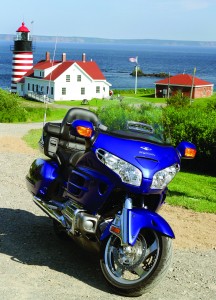
Nova Scotians explained to me that their province is a bit larger than Denmark and a bit smaller than Scotland. I asked an Acadian—one of the 18 percent of Nova Scotia’s population that claims French ancestry—what the words Nova Scotia mean, and she claimed she didn’t know. I asked a Scot and he thundered, “It means New Scotland.” This Canadian/Scottish/French island of Cape Breton is about a third larger than Rhode Island.
We picked up the bike in New York on a day that seemed determined to dissuade us from this ride. The moist summer sky drizzled as we packed the bike in the showroom. By the time we fired up the big Honda, the skies were offering us a waterfall and our departure seemed like some kind of sad lost cause. Sharon’s quiet eyes expressed doubt about motorcycle travel. I made a feeble attempt at confidence as I wobbled the unfamiliar bike out into the storm.
As an Oregon boy, I’m unaccustomed to humidity and random warm rain showers. Months earlier, I had researched the mysteries of East Coast weather. As a result, I’d picked up mesh jackets and pants with waterproof linings—Firstgear Air. To my delight, these worked perfectly in light to moderate rain, but I doubt if anything would have kept us completely dry in the 3 inches of record-setting rain that immersed us that first day. The Gold Wing ran so well, I suspect it can function underwater. The luggage compartments did not leak, and we sloshed into our motel room that night amazingly dry under our riding clothes. On the return trip we would pack ourselves in several gallons of ice under these jackets to survive the triple-digit temperatures that dared us to return to New York.
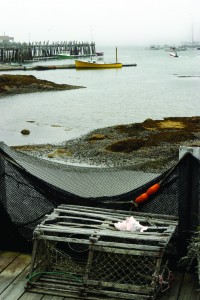
Besides all the wet metal plates on the streets of New York, we experienced a traffic jam that lasted eight hours. Our first day we were only able to get 100 miles before darkness and exhaustion forced us off the road. At a lunch stop, I looked at the platter-sized rainwater puddles gathering under Sharon as we studied our sopping, disintegrating map to figure out where we would spend the first night. She didn’t complain, but at that point this trip appeared to be a huge mistake. My kingdom for a rental car.
After that, each day seemed to improve as we made our way north. Looking back, we long to return to New Hampshire’s White Mountains, Maine’s rugged coast and the white steepled villages that dot the journey like pearls on a necklace.
As we toured our way northward our slow pace surprised us. Oregon has three rural counties larger than Connecticut. You set your cruise control at 65 or higher and don’t turn it off for hours. New England rural roads have lower speed limits, patches of low-quality pavement and apparently random 35-mph zones. Soon I became accustomed to these quirks and surrendered myself to loving these roads.
Some people think that the destination decides the success or failure of a journey. These people don’t decide until they reach the top if the hike was worth the uphill climb. Not knowing if Cape Breton would be worth all the trouble of getting there, we made it a priority to enjoy the journey to Nova Scotia, despite any bad weather.
We explored the White Mountains of New Hampshire, Acadia National Park in Maine, the Bay of Fundy in New Brunswick, and the softness of Prince Edward Island (P.E.I.). Each place made us decide the trip was worth it, and we hadn’t even ridden the Cabot Trail yet.
How to get to the Cabot Trail? First of all, it’s located in the northernmost part of Nova Scotia. Since we wanted to hit the natural wonders on our way, our route followed a zigzag but persistently northern track. Before Nova Scotia, we spent two days on P.E.I. This must be one of the most relaxing places on earth. Its pastoral beauty, rusty red earth and friendly people made us want to loiter.
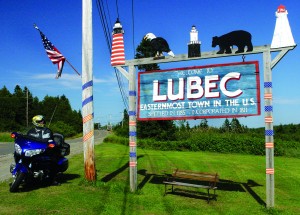
Riders know something that few other people know. When a group of motorcyclists find themselves together, they make friends. On the ferry from P.E.I. to Nova Scotia, we relaxed with other riders whom onlookers probably assumed were longtime friends. It’s the way of motorcycle travel, and we love it.
Cape Breton was discovered by explorer John Cabot in 1497. Its non-native population came from Scottish immigrants who were fleeing the social upheaval due to the ending of the clan system, French Acadians who refused to be expelled from Canada, Loyalists—Americans on the losing side of the Revolutionary War—and other Europeans. Lucky for modern tourists, many of these ethnic groups cling stubbornly to their roots. As a result, a visitor can hear, see and taste the culture of these peoples. I love listening to the folk music on the local radio stations.
After all the beautiful places we toured on our way to Cape Breton, we expected more of the same. We didn’t get the same. We got better. The difference in beauty between Cape Breton and everything else we saw is like a garden strawberry and a wild strawberry. The first is terrific, the other more terrific, wild and strong.
Nothing made us happier than to be on a motorcycle traveling the wild Cape Breton Highlands National Park. From the bike we could sense a pounding, throbbing urge for plants and animals to reproduce, a patient desire for erosion to tear down the rocky highlands, and a drive to make pure sand from shells, waves and stones. An untamed energy and pristine harsh cleanliness allows fragile frogs to thrive, eagles to raise their awkward young, peat moss to add another annual eighth-inch to its hundred-year-old thickness and an ancient hardwood forest to flourish unblemished by human footprint or lumberman’s ax.
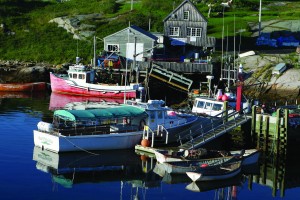
In the Acadian village of Cheticamp, the lilting, natural French spoken by the residents makes everything they say sound poetic. I would feign interest in a handmade hooked rug just to listen to the locals gossip. We made this little town our base as we explored the national park.
Motorcycle travelers to this part of the world need to understand some things about the Cabot Trail. It was begun in the late 1920s to connect isolated fishing villages and encourage tourism. Because the vehicles during that time lacked sufficient horsepower to travel up steep grades, gradual elevation changes were accomplished with dozens of switchbacks. Most riders love these kinds of roads.
Much of the Cabot Trail is in perfect condition. The roads move through hill, cliff and mountain with a consummate natural fluidity. Maybe it was the Gold Wing, but they seemed to possess a strong abiding grace that still calls to me. But in some places, the pavement quality would embarrass Uganda. The Gold Wing has remotely adjustable suspension, and it needed lots of adjustment. Often we found ourselves staring at the road with utmost concentration to avoid hitting a bump that would compress the shock to its limit. Many of these bumps are easy to spot, but others are somehow invisible, remorseless and require travel far slower than the posted speed limits. Sometimes a wild strawberry can be too sour.
Not all riders like to hike. There are two half-mile hikes that even people who hate hiking should take. One is the Bog Trail where you can see the wild orchids, carnivorous plants and highland frogs. The other is the Lone Sheiling trail through a 10,000-year-old virgin hardwood forest. I suggest you bring lace-up waterproof boots on a trip like this that involves rain and hiking. I used my Oxtar Jupiter boots. When you pay your park entrance fee, ask for a trail map.
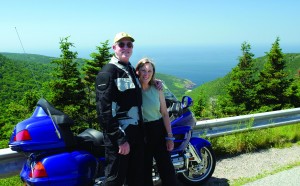
Perhaps the most touching aspect of Nova Scotia is the persistent kindness of the people. In all of our travels, we’ve never found a more friendly, giving people than the Nova Scotians. They were so kind, we forgave them for the bad spots in their roads.
On our last night in Cheticamp, I put a couple of haddock filets on the outside grill of our rented cabin and opened a bottle of a fine local wine, Cotê de Bras d’Or, Marechal Fock 2003, by Jost Vineyards. As we shared a desert of local strawberries, we thought back to the cruel rainstorm that began this wonderful trip, the abundant natural beauty and charm of our Maritime adventure, and the friendly people we met. As we sipped, the sun set in a blaze of colors over the Gulf of St. Lawrence, and we vowed to return on our next big anniversary.
[From the April 2006 issue of Rider]

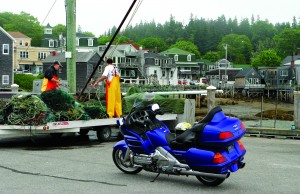
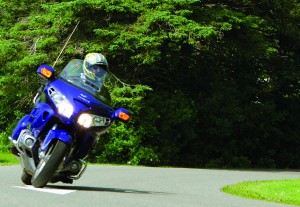
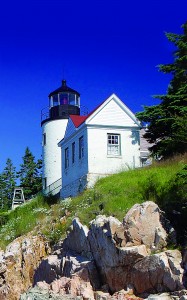
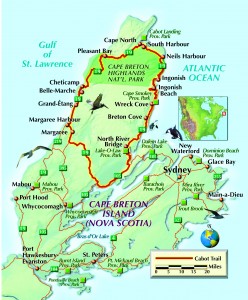








Love your story it really tells the beauty of Nova Scotia and Cape Breton.
I did spotted a mistake at the bottom of the article where you have a picture of a lighthouse. This is not Peggy’s Cove lighthouse since there is a tree on beside it. Peggy’s Cove is all Granite rock with no trees what so ever